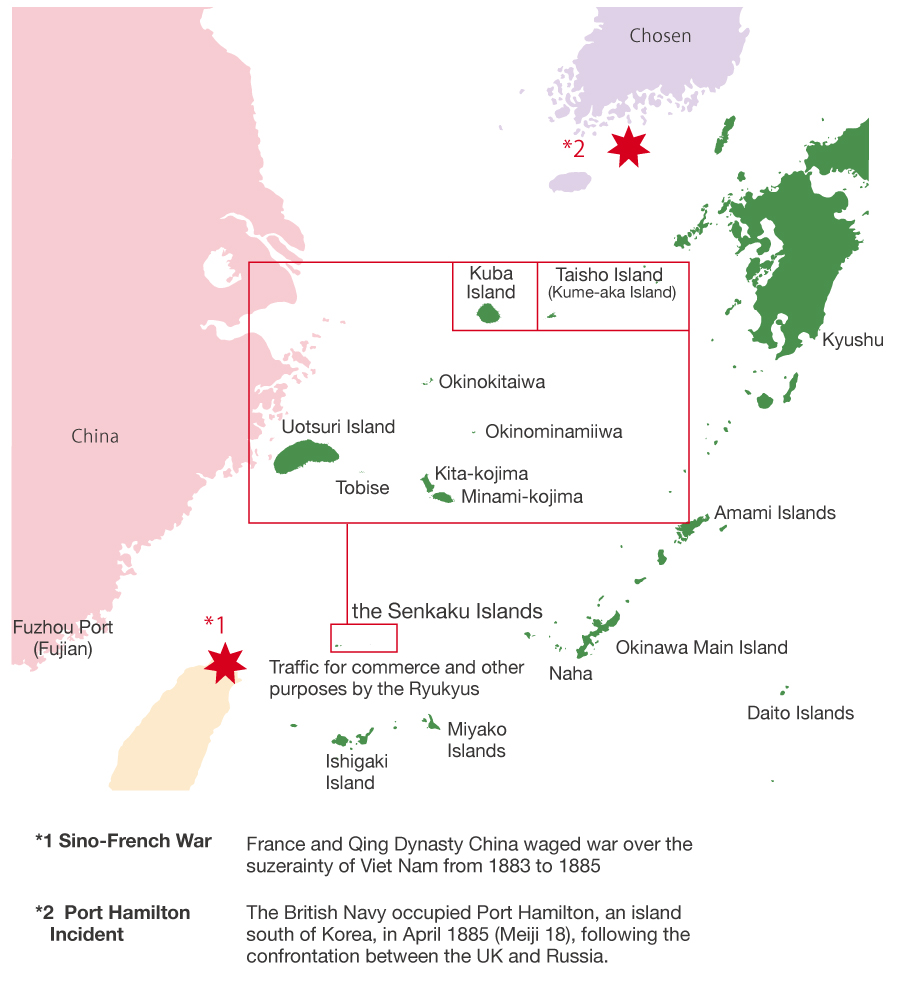Senkaku Islands
– uninhabited islands ruled by no country
Until the late 19th century
Areas surrounding the East China Sea and the Senkaku Islands before the Islands’ incorporation into the Japanese territory
Until the second half of the 19th Century, the Senkaku Islands were uninhabited islands around the Ryukyu Islands that belonged to no country around the Ryukyu Islands.
After the Meiji Restoration in 1868, Japan modernized its administrative organization domestically, while externally making efforts to enhance its status in the modern international community, such as by revising unequal treaties signed with other nations, at a time when western powers were advancing into Asia.
As the situation around the East China Sea had become more volatile, the Meiji Government faced critical challenges in clarifying the status of peripheral islands including the Senkaku Islands. Such challenges became even more critical in the 1880s, when tension was increasing with the growing presence of western powers in East Asia, exemplified by the outbreak of the Sino-French War(*1) (1883-85) and the Port Hamilton Incident(*2) (April 1885).
Situation in the Senkaku Islands No.1
The Senkaku Islands were used as a navigation marker for vessels passing through the East China Sea. The existence of the Islands was known, as they appeared in documents and maps of the Ryukyu Dynasty (see No.1 below). There is a record of a member of the Ryukyu royal family landing on them around 1819 and that of Ryukyu people approaching the Islands to investigate them in 1859.
Nonetheless, the Senkaku Islands, which were uninhabited, were never administered by any other country before Japan incorporated them into its territory in 1895.
Situation in the Ryukyus
In the Edo Period, the Ryukyu Dynasty was under the rule of Satsuma Domain, and the Edo Shogunate regarded the dynasty as part of Satsuma Domain. In the meantime, the dynasty paid tribute to the Qing and traded through Fuzhou, an official port.
After the Meiji Restoration, the Ryukyu Dynasty turned into the Ryukyu Domain in 1872, clarifying its affiliation to Japan, and later became Okinawa Prefecture in 1879.
Scroll of the Ryukyus depicting a navigation route
This is a scroll that depicts a navigation route between Naha Port in the Ryukyu Dynasty and Fuzhou Port in China (year of production unknown.). The route in this scroll indicates that vessels departed from Fuzhou Port, travelled through Uotsuri Island, Kuba Island, Kume-aka (Taisho) Island, and Kume Island, and reached Naha Port.
The Senkaku Islands also appear in Chinese records such as the records by Chinese Envoys of the Ming and Qing Dynasties. What is noteworthy about this scroll is the writing of the island names, with the names used in the records of Chinese Envoys (e.g. Kobi-sho) shown above, and the names used in the Ryukyus (e.g. Kuba Island) shown below.

[Repository] Okinawa Prefectural Museum and Art Museum (Tobin Koukaizu)








